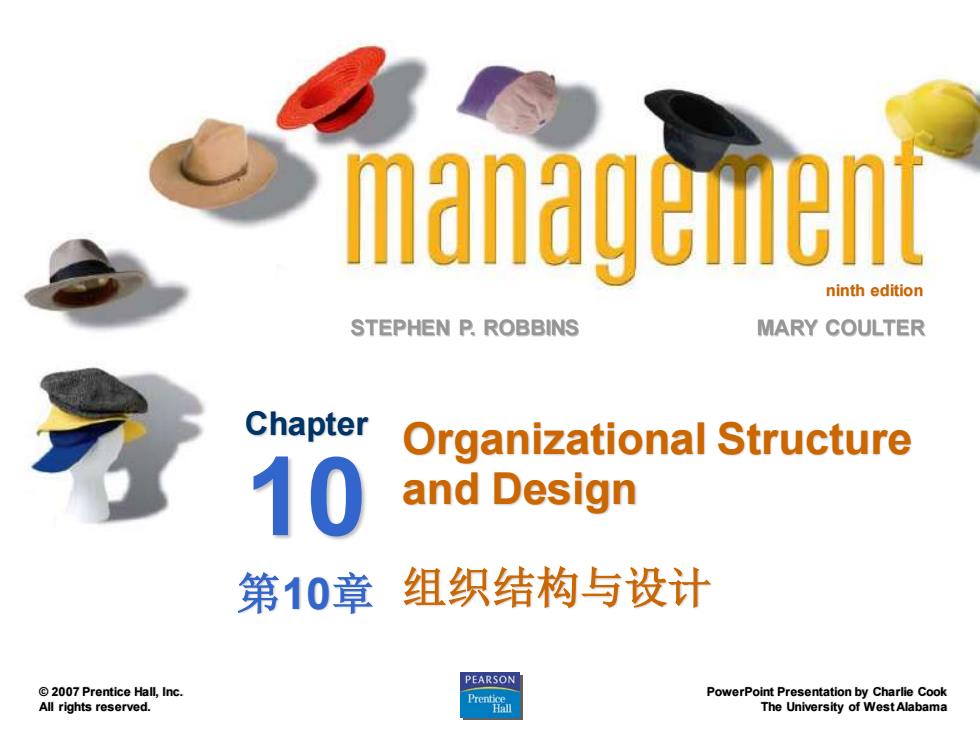
management ninth edition STEPHEN P.ROBBINS MARY COULTER Chapter Organizational Structure 10 and Design 第10章 组织结构与设计 PEARSON 2007 Prentice Hall,Inc. PowerPoint Presentation by Charlie Cook All rights reserved. 器 The University of WestAlabama
ninth edition STEPHEN P. ROBBINS PowerPoint Presentation by Charlie Cook The University of West Alabama MARY COULTER © 2007 Prentice Hall, Inc. All rights reserved. Organizational Structure and Design 组织结构与设计 Chapter 10 第10章
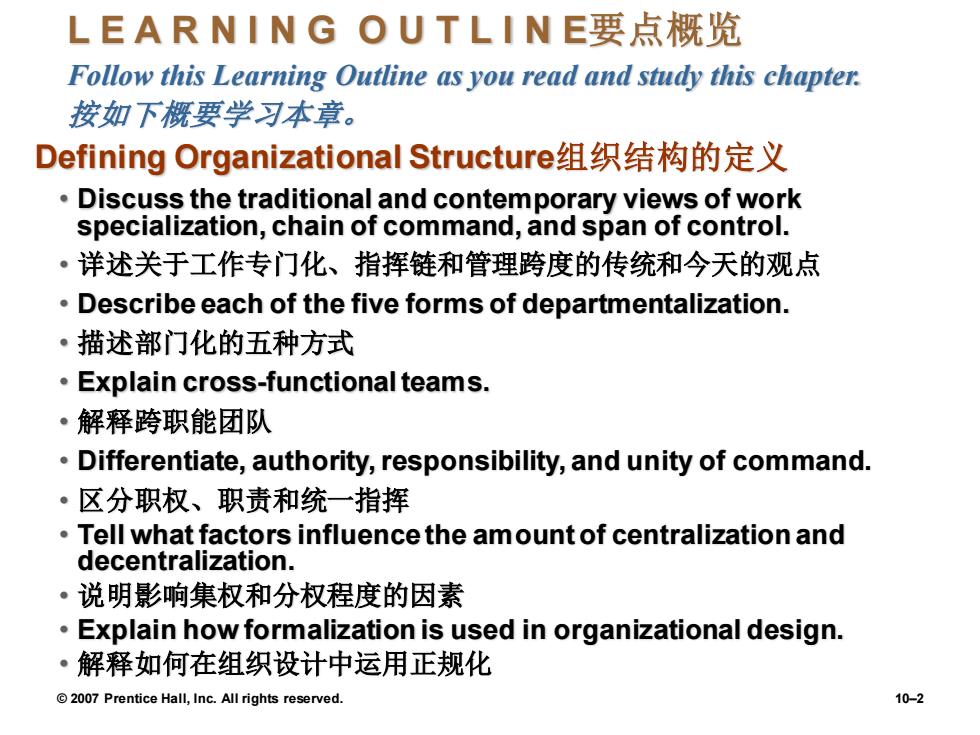
LEARNING OUTLINE要点概览 Follow this Learning Outline as you read and study this chapter. 按如下概要学习本章。 Defining Organizational Structure组织结构的定义 Discuss the traditional and contemporary views of work specialization,chain of command,and span of control. ·详述关于工作专门化、指挥链和管理跨度的传统和今天的观点 Describe each of the five forms of departmentalization. ·描述部门化的五种方式 Explain cross-functional teams. ·解释跨职能团队 Differentiate,authority,responsibility,and unity of command. ·区分职权、职责和统一指挥 Tell what factors influence the amount of centralization and decentralization. ·说明影响集权和分权程度的因素 Explain how formalization is used in organizational design. ·解释如何在组织设计中运用正规化 2007 Prentice Hall,Inc.All rights reserved. 10-2
© 2007 Prentice Hall, Inc. All rights reserved. 10–2 L E A R N I N G O U T L I N E要点概览 Follow this Learning Outline as you read and study this chapter. 按如下概要学习本章。 Defining Organizational Structure组织结构的定义 • Discuss the traditional and contemporary views of work specialization, chain of command, and span of control. • 详述关于工作专门化、指挥链和管理跨度的传统和今天的观点 • Describe each of the five forms of departmentalization. • 描述部门化的五种方式 • Explain cross-functional teams. • 解释跨职能团队 • Differentiate, authority, responsibility, and unity of command. • 区分职权、职责和统一指挥 • Tell what factors influence the amount of centralization and decentralization. • 说明影响集权和分权程度的因素 • Explain how formalization is used in organizational design. • 解释如何在组织设计中运用正规化

LEARNING OUTLINE(cont'd要点概览(续) Follow this Learning Outline as you read and study this chapter. 按如下概要学习本章。 Organizational Design Decisions:组织设计决策 Contrast mechanistic and organic organizations. ·比较机械式组织和有机式组织 Explain the relationship between strategy and structure. ·解释战略和结构之间关系 Tell how organizational size affects organizational design. ·说明组织规模怎样影响组织设计 Discuss Woodward's findings on the relationship of technology and structure. ·详述伍德沃德关于技术和结构之间关系的发现 Explain how environmental uncertainty affects organizational design. ·解释环境不确定性是如何影响组织设计的 2007 Prentice Hall,Inc.All rights reserved 10-3
© 2007 Prentice Hall, Inc. All rights reserved. 10–3 L E A R N I N G O U T L I N E (cont’d)要点概览(续) Follow this Learning Outline as you read and study this chapter. 按如下概要学习本章。 Organizational Design Decisions组织设计决策 • Contrast mechanistic and organic organizations. • 比较机械式组织和有机式组织 • Explain the relationship between strategy and structure. • 解释战略和结构之间关系 • Tell how organizational size affects organizational design. • 说明组织规模怎样影响组织设计 • Discuss Woodward’s findings on the relationship of technology and structure. • 详述伍德沃德 关于技术和结构之间关系的发现 • Explain how environmental uncertainty affects organizational design. • 解释环境不确定性是如何影响组织设计的
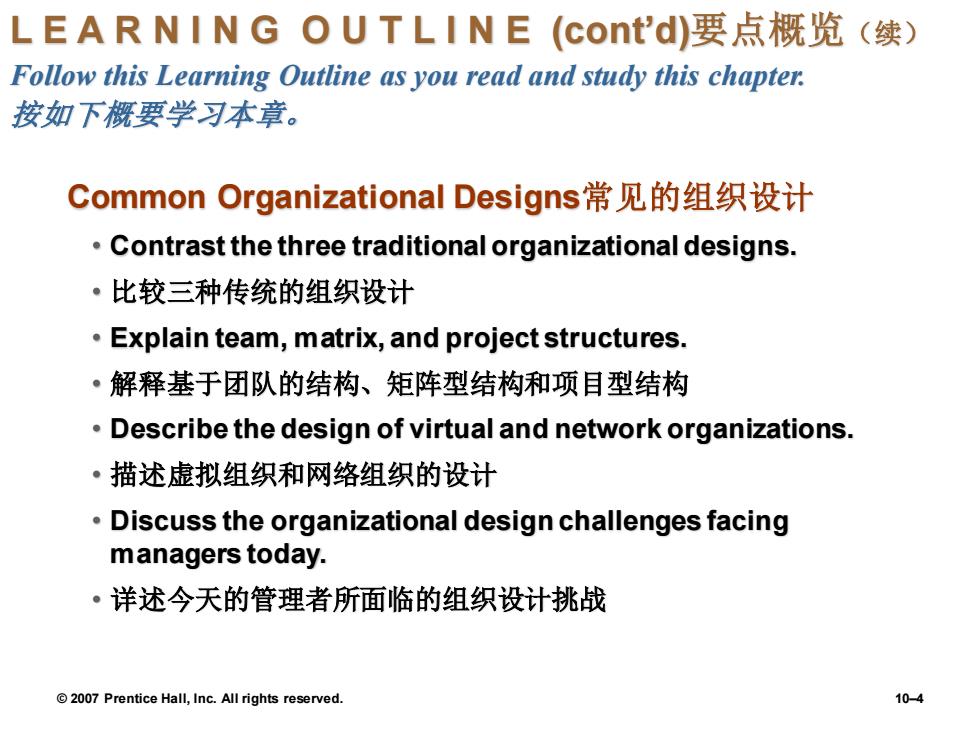
LEARNING OUTLINE(cont'd要点概览(续) Follow this Learning Outline as you read and study this chapter. 按如下概要学习本章。 Common Organizational Designs常见的组织设计 Contrast the three traditional organizational designs. ·比较三种传统的组织设计 Explain team,matrix,and project structures. ·解释基于团队的结构、矩阵型结构和项目型结构 Describe the design of virtual and network organizations. ·描述虚拟组织和网络组织的设计 Discuss the organizational design challenges facing managers today. ·详述今天的管理者所面临的组织设计挑战 2007 Prentice Hall,Inc.All rights reserved. 10-4
© 2007 Prentice Hall, Inc. All rights reserved. 10–4 L E A R N I N G O U T L I N E (cont’d)要点概览(续) Follow this Learning Outline as you read and study this chapter. 按如下概要学习本章。 Common Organizational Designs常见的组织设计 • Contrast the three traditional organizational designs. • 比较三种传统的组织设计 • Explain team, matrix, and project structures. • 解释基于团队的结构、矩阵型结构和项目型结构 • Describe the design of virtual and network organizations. • 描述虚拟组织和网络组织的设计 • Discuss the organizational design challenges facing managers today. • 详述今天的管理者所面临的组织设计挑战
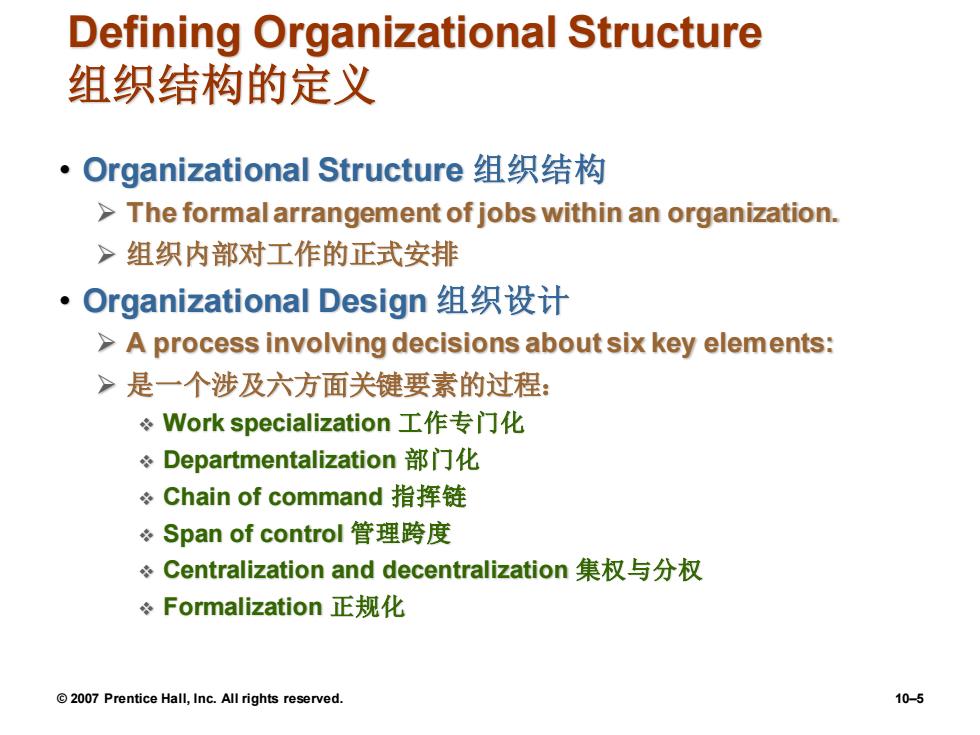
Defining Organizational Structure 组织结构的定义 ·Organizational Structure组织结构 The formal arrangement of jobs within an organization. >组织内部对工作的正式安排 ·Organizational Design组织设计 >A process involving decisions about six key elements: >是一个涉及六方面关键要素的过程: 冬Work specialization工作专门化 ÷Departmentalization部门化 。Chain of command指挥链 ÷Span of control管理跨度 冬Centralization and decentralization集权与分权 ÷Formalization正规化 2007 Prentice Hall,Inc.All rights reserved. 10-5
© 2007 Prentice Hall, Inc. All rights reserved. 10–5 Defining Organizational Structure 组织结构的定义 • Organizational Structure 组织结构 ➢ The formal arrangement of jobs within an organization. ➢ 组织内部对工作的正式安排 • Organizational Design 组织设计 ➢ A process involving decisions about six key elements: ➢ 是一个涉及六方面关键要素的过程: ❖ Work specialization 工作专门化 ❖ Departmentalization 部门化 ❖ Chain of command 指挥链 ❖ Span of control 管理跨度 ❖ Centralization and decentralization 集权与分权 ❖ Formalization 正规化
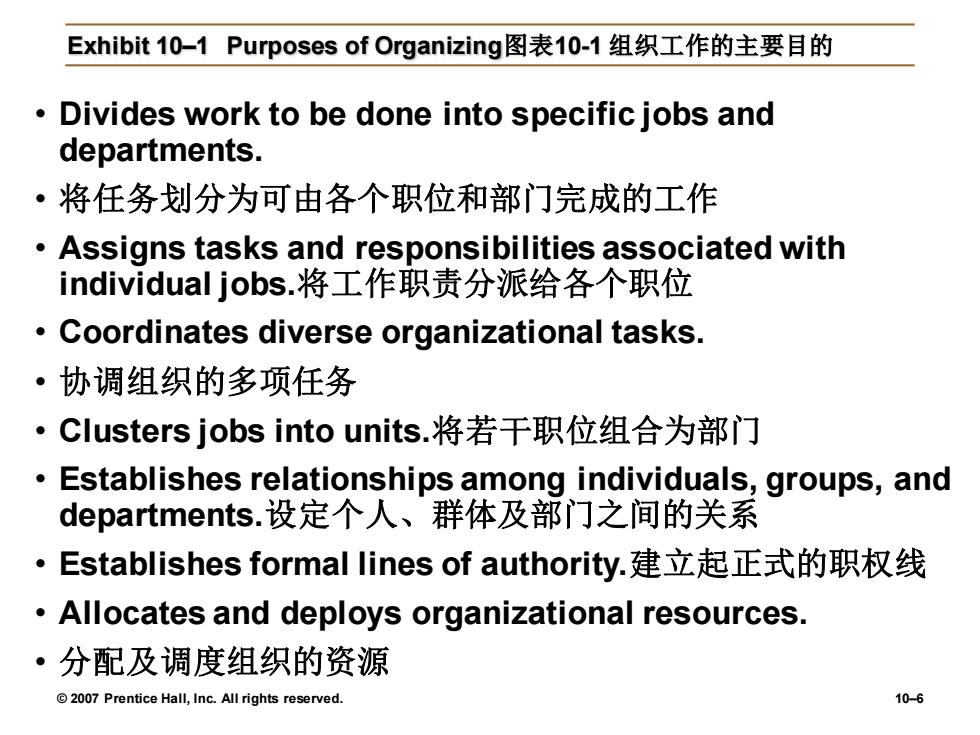
Exhibit10-1 Purposes of Organizing图表10-1组织工作的主要目的 Divides work to be done into specific jobs and departments. ·将任务划分为可由各个职位和部门完成的工作 Assigns tasks and responsibilities associated with individual jobs.将工作职责分派给各个职位 Coordinates diverse organizational tasks. ·协调组织的多项任务 ·Clusters jobs into units.将若干职位组合为部门 Establishes relationships among individuals,groups,and departments.设定个人、群体及部门之间的关系 ·Establishes formal lines of authority.建立起正式的职权线 Allocates and deploys organizational resources. ·分配及调度组织的资源 2007 Prentice Hall,Inc.All rights reserved. 10-6
© 2007 Prentice Hall, Inc. All rights reserved. 10–6 Exhibit 10–1 Purposes of Organizing图表10-1 组织工作的主要目的 • Divides work to be done into specific jobs and departments. • 将任务划分为可由各个职位和部门完成的工作 • Assigns tasks and responsibilities associated with individual jobs.将工作职责分派给各个职位 • Coordinates diverse organizational tasks. • 协调组织的多项任务 • Clusters jobs into units.将若干职位组合为部门 • Establishes relationships among individuals, groups, and departments.设定个人、群体及部门之间的关系 • Establishes formal lines of authority.建立起正式的职权线 • Allocates and deploys organizational resources. • 分配及调度组织的资源
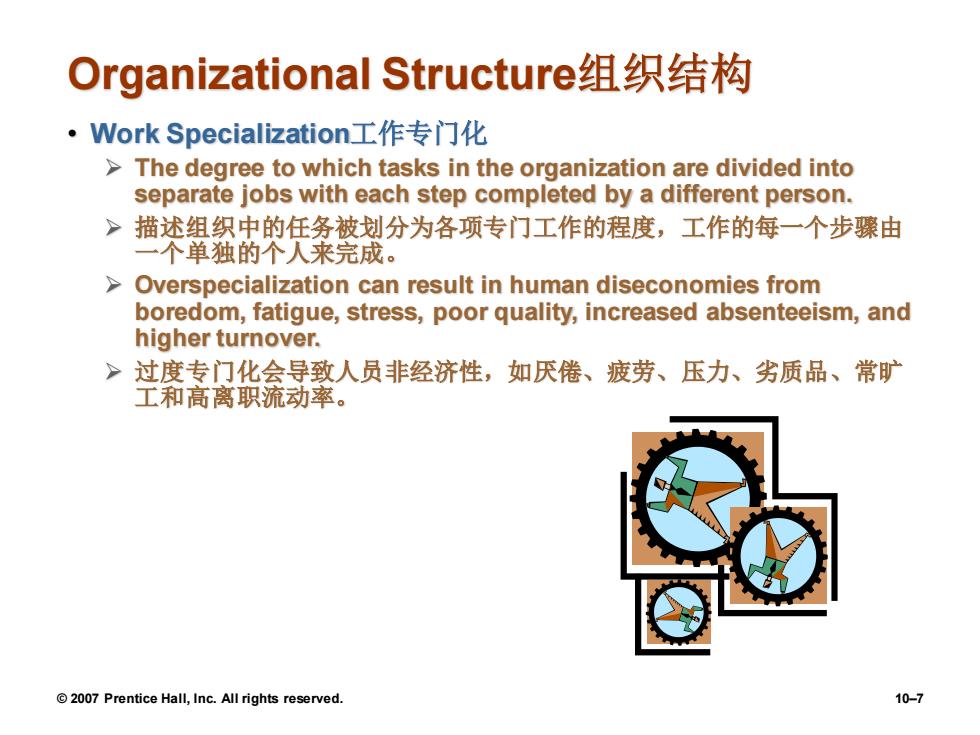
Organizational Structure:组织结构 ·Work Specialization.工作专门化 The degree to which tasks in the organization are divided into separate jobs with each step completed by a different person. >描述组织中的任务被划分为各项专门工作的程度,工作的每一个步骤由 一个单独的个人来完成。 >Overspecialization can result in human diseconomies from boredom,fatigue,stress,poor quality,increased absenteeism,and higher turnover. >过度专门化会导致人员非经济性,如厌倦、疲劳、压力、劣质品、常旷 工和高离职流动率。 2007 Prentice Hall,Inc.All rights reserved. 10-7
© 2007 Prentice Hall, Inc. All rights reserved. 10–7 Organizational Structure组织结构 • Work Specialization工作专门化 ➢ The degree to which tasks in the organization are divided into separate jobs with each step completed by a different person. ➢ 描述组织中的任务被划分为各项专门工作的程度,工作的每一个步骤由 一个单独的个人来完成。 ➢ Overspecialization can result in human diseconomies from boredom, fatigue, stress, poor quality, increased absenteeism, and higher turnover. ➢ 过度专门化会导致人员非经济性,如厌倦、疲劳、压力、劣质品、常旷 工和高离职流动率
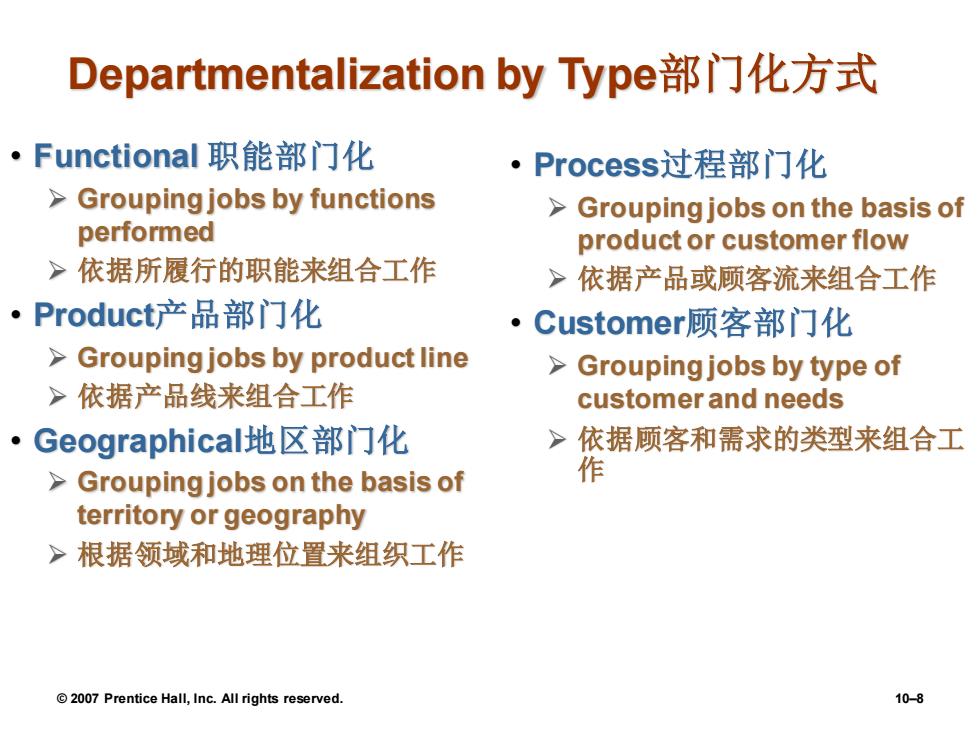
Departmentalization by Type部门化方式 ·Functional职能部门化 ·Process过程部门化 >Groupingjobs by functions >Grouping jobs on the basis of performed product or customer flow >依据所履行的职能来组合工作 >依据产品或顾客流来组合工作 ·Product产品部门化 ·Customer顾客部门化 >Groupingjobs by product line Groupingjobs by type of >依据产品线来组合工作 customer and needs ·Geographical地区部门化 >依据顾客和需求的类型来组合工 >Groupingjobs on the basis of 作 territory or geography >根据领域和地理位置来组织工作 2007 Prentice Hall,Inc.All rights reserved. 10-8
© 2007 Prentice Hall, Inc. All rights reserved. 10–8 Departmentalization by Type部门化方式 • Functional 职能部门化 ➢ Grouping jobs by functions performed ➢ 依据所履行的职能来组合工作 • Product产品部门化 ➢ Grouping jobs by product line ➢ 依据产品线来组合工作 • Geographical地区部门化 ➢ Grouping jobs on the basis of territory or geography ➢ 根据领域和地理位置来组织工作 • Process过程部门化 ➢ Grouping jobs on the basis of product or customer flow ➢ 依据产品或顾客流来组合工作 • Customer顾客部门化 ➢ Grouping jobs by type of customer and needs ➢ 依据顾客和需求的类型来组合工 作
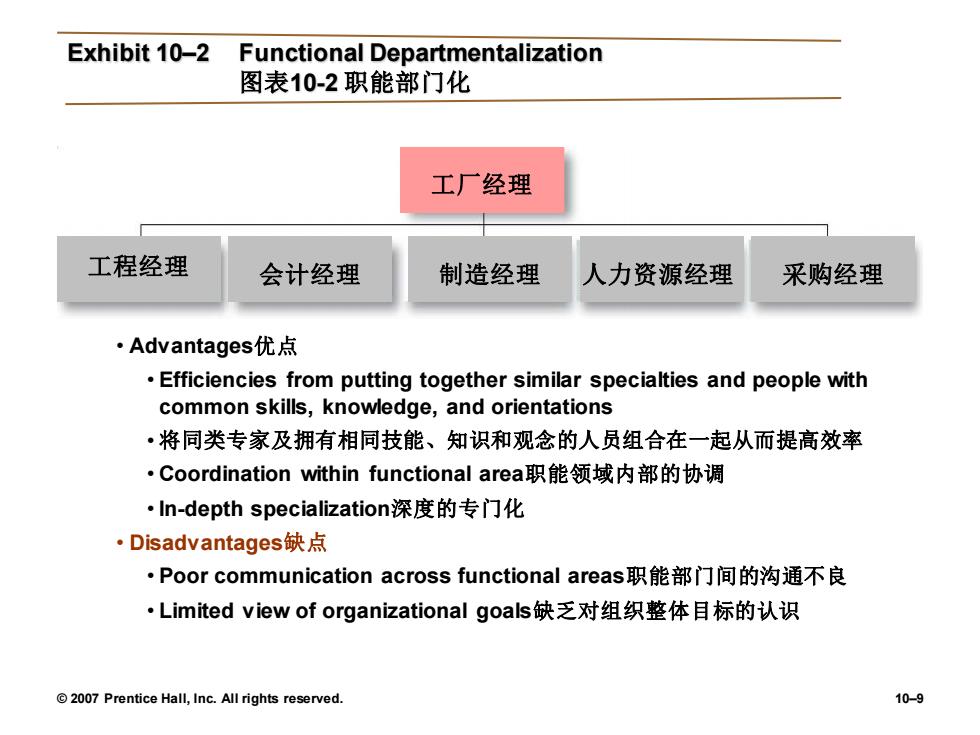
Exhibit 10-2 Functional Departmentalization 图表10-2职能部门化 工厂经理 工程经理 会计经理 制造经理 人力资源经理 采购经理 ·Advantages优点 Efficiencies from putting together similar specialties and people with common skills,knowledge,and orientations ·将同类专家及拥有相同技能、知识和观念的人员组合在一起从而提高效率 ·Coordination within functional area职能领域内部的协调 ·ln-depth specialization深度的专门化 ·Disadvantages缺点 ·Poor communication across functional areas?职能部门间的沟通不良 ·Limited view of organizational goals缺乏对组织整体目标的认识 2007 Prentice Hall,Inc.All rights reserved. 10-9
© 2007 Prentice Hall, Inc. All rights reserved. 10–9 Exhibit 10–2 Functional Departmentalization 图表10-2 职能部门化 • Advantages优点 • Efficiencies from putting together similar specialties and people with common skills, knowledge, and orientations • 将同类专家及拥有相同技能、知识和观念的人员组合在一起从而提高效率 • Coordination within functional area职能领域内部的协调 • In-depth specialization深度的专门化 • Disadvantages缺点 • Poor communication across functional areas职能部门间的沟通不良 • Limited view of organizational goals缺乏对组织整体目标的认识 工厂经理 工程经理 会计经理 制造经理 人力资源经理 采购经理
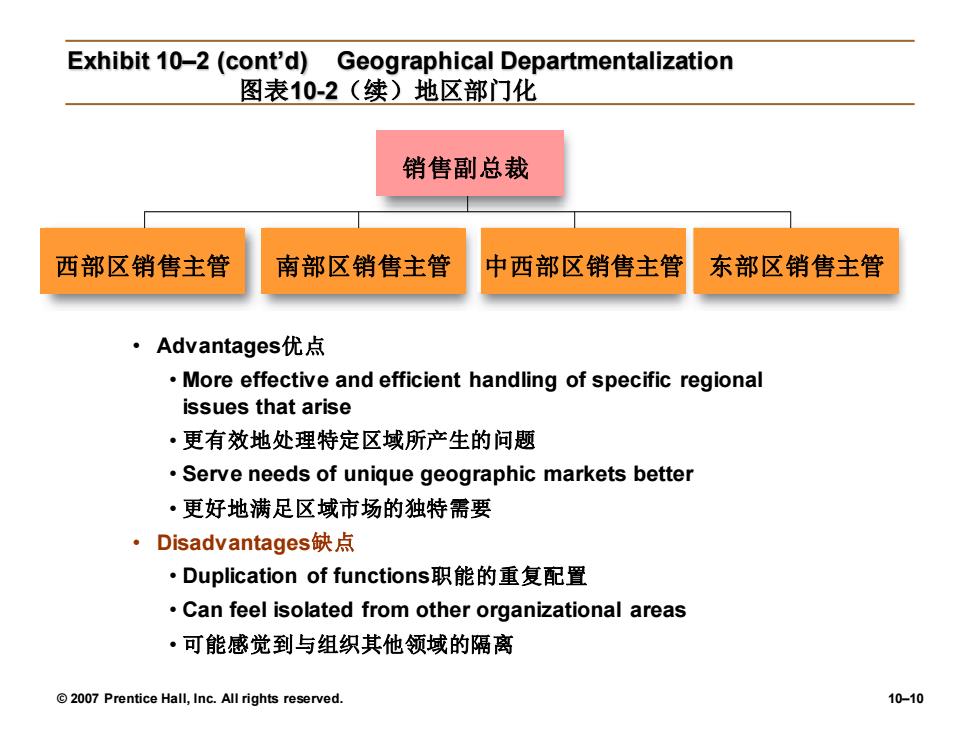
Exhibit 10-2(cont'd) Geographical Departmentalization 图表10-2(续)地区部门化 销售副总裁 西部区销售主管 南部区销售主管 中西部区销售主管 东部区销售主管 ·Advantages优点 More effective and efficient handling of specific regional issues that arise ·更有效地处理特定区域所产生的问题 Serve needs of unique geographic markets better ·更好地满足区域市场的独特需要 ·Disadvantagest缺点 ·Duplication of functions职能的重复配置 Can feel isolated from other organizational areas ·可能感觉到与组织其他领域的隔离 2007 Prentice Hall,Inc.All rights reserved. 10-10
© 2007 Prentice Hall, Inc. All rights reserved. 10–10 Exhibit 10–2 (cont’d) Geographical Departmentalization 图表10-2(续)地区部门化 • Advantages优点 • More effective and efficient handling of specific regional issues that arise • 更有效地处理特定区域所产生的问题 • Serve needs of unique geographic markets better • 更好地满足区域市场的独特需要 • Disadvantages缺点 • Duplication of functions职能的重复配置 • Can feel isolated from other organizational areas • 可能感觉到与组织其他领域的隔离 销售副总裁 西部区销售主管 南部区销售主管 中西部区销售主管 东部区销售主管